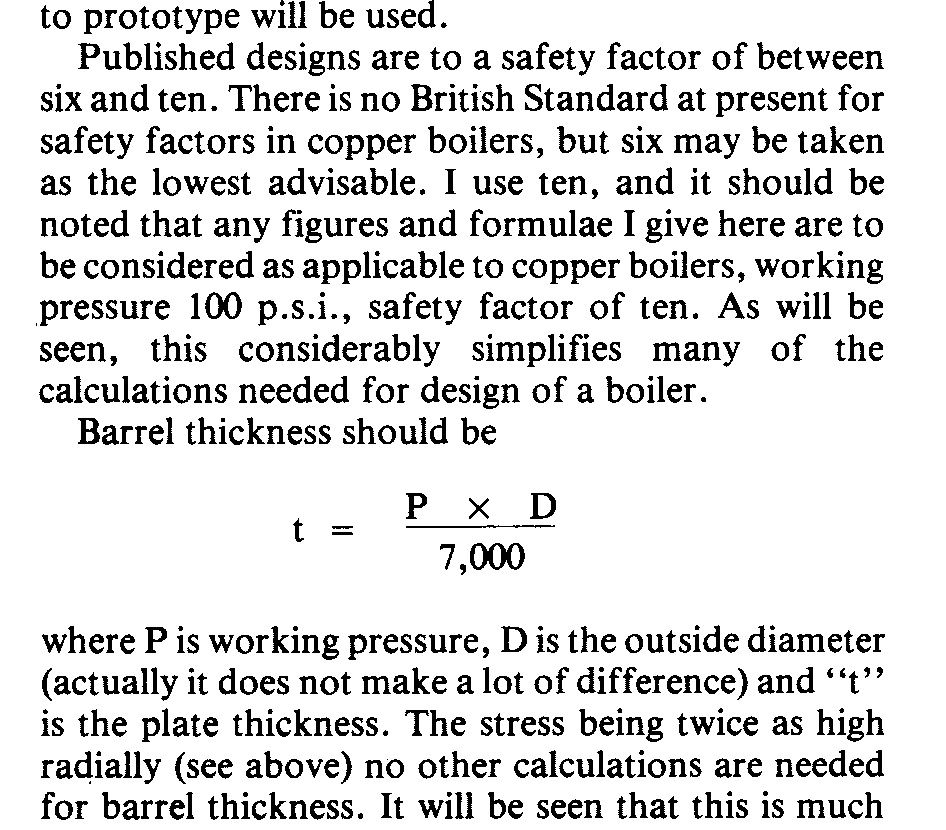Dave, if girder crown stays are not banned they are allowed, there is no room for inference in standards. You just need to justify them
I can't make the spreadsheet work, it downloads but then I can't enter anything in the boxes. However it still doesn't reference back to any national standard, which is my gripe all along. Note the get out clause on line 4 'All of these are for guidance only and should not be the sole basis for any designs. It appears OK as far it goes but it makes no mention for instance of reinforcement around big holes in the barrel for domes.
BS5500 is based around 0.2% proof stress at the appropriate working temperature and requires a factor of safety of 1.5 between working and proof stress. However it also requires a test pressure of 1.25 times working pressure. This means that at cold pressure test the stress would be proof stress/1.2. According to the Copper Development Association the cold proof stress of annealed copper is 9370 psi, so stress at pressure test should be < 9370/1.2= 7808 psi, and therefore stress at working pressure should be <7808/2=3904 psi, this is less than that suggested in the spreadsheet. Does this matter? Well probably not, the stress at test pressure (8000 psi) would still be comfortably below proof. The proof stress at the temperature corresponding to 100 psi is 8909 psi, so using my 3904 figure the factor of safety at working pressure is 2.3, which is well above the 1.5 required and so there is no need to have any arguments about whether to make design pressure higher than working pressure to allow for safety valve accumulation. The Australian code quotes 3771 psi. In the interests of international harmony I'd plump for this figure, then if you emigrate and take your loco with you it might still be acceptable. And yes I do know that BS5500 is superseded, but it's the only one to which I had access. I haven't checked the spreadsheet values for stay spacing, but have no reason to doubt them.
There are some aspects of the Aussy code which I find restrictive, for instance the ban on end to end longitudinal stays silver soldered both ends, but I can see why, it is very easy to finish up with such stays slack due to differential heating. Don't ask me how I know. They also ban connecting the top and bottom water gauge fittings by anything other than the gauge glass. I do see the argument, but I'm not sure how valid it is.
The current SFED position is illogical, it requires justification in some circumstances but doesn't mention what stress is acceptable. All I'm agitating for is for the SFED to come out of the woodwork and tell us. Complicated calculations are not needed, the tables in the Aussy code or a simple spreadsheet would suffice. It could be produced in both imperial and metric very easily. I would offer to do it, but it would need to be endorsed by SFED, I don't have Professional Indemnity Insurance any more.
This is all aimed at designing boilers which will pass the 2*wp test, you'd be a bit sick if having invested hundreds of £ and a lot of effort it failed. Again I know this doesn't happen often but we had one in our club years ago where the crown came down.
Edited By duncan webster on 20/01/2021 16:14:26
Benedict White.





